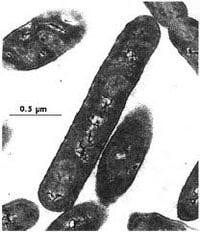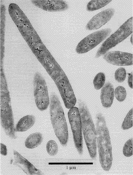Bacillus infernus: Difference between revisions
No edit summary |
No edit summary |
||
| Line 8: | Line 8: | ||
===Species=== | ===Species=== | ||
[[Image:infernus.gif|thumb|left|x175px|link=http://www.ncbi.nlm.nih.gov/pubmed/8590670|''Bacillus infernus'', a hyperthermophile, found 2.65-2.77 km beneath the Earth's surface. Photo courtesy of US Department of Energy- Subsurface Microbial Collection.]][[Image:infernus.jpeg|thumb|right|200px|link=http://geoweb.princeton.edu/research/geomicrobio/bacteria.html|Thin-section electron micrograph of Bacillus infernus, sp. nov., isolated from ca. 2.7 km below land surface in the Taylorsville Basin. These new species proposed by D. R. Boone et al. (1995) are thermophilic, halotolerant, and Fe(III)- and Mn(IV)-reducing anaerobes. Photo from http://geoweb.princeton.edu/research/geomicrobio/bacteria.html]][[Image:andromeda.jpg|thumb|Border|right|Alignment|Size|link=http://en.wikipedia.org/wiki/The_Andromeda_Strain_(2008_miniseries)|alt=Alt|Tests with ''B. infernus'' reveal that the bacterium easily consumes and destroys Andromeda because of Andromeda's sulfur structure....SCIENTIFIC?? NO!!! BUT FUN?? YES!!! Photo from Wikipedia.]] | [[Image:infernus.gif|thumb|left|x175px|link=http://www.ncbi.nlm.nih.gov/pubmed/8590670|''Bacillus infernus'', a hyperthermophile, found 2.65-2.77 km beneath the Earth's surface. Photo courtesy of US Department of Energy- Subsurface Microbial Collection.]][[Image:infernus.jpeg|thumb|right|200px|link=http://geoweb.princeton.edu/research/geomicrobio/bacteria.html|Thin-section electron micrograph of Bacillus infernus, sp. nov., isolated from ca. 2.7 km below land surface in the Taylorsville Basin. These new species proposed by D. R. Boone et al. (1995) are thermophilic, halotolerant, and Fe(III)- and Mn(IV)-reducing anaerobes. Photo from http://geoweb.princeton.edu/research/geomicrobio/bacteria.html]][[Image:andromeda.jpg|thumb|upright 1.5|Border|right|Alignment|Size|link=http://en.wikipedia.org/wiki/The_Andromeda_Strain_(2008_miniseries)|alt=Alt|Tests with ''B. infernus'' reveal that the bacterium easily consumes and destroys Andromeda because of Andromeda's sulfur structure....SCIENTIFIC?? NO!!! BUT FUN?? YES!!! Photo from Wikipedia.]] | ||
''Bacillus infernus'' | ''Bacillus infernus'' | ||
Revision as of 20:37, 28 April 2012
A Microbial Biorealm page on the genus Bacillus infernus
Classification
Higher order taxa
Bacteria; Firmicutes; Bacilli; Bacillales; Bacillaceae; Bacillus
Species

Bacillus infernus
Nonmotile rods (including possible yet unconfirmed endospores) inhabiting the deep terrestrial subsurface of the Taylorsville, Virginia Triassic Basin. The organism is thermophilic, halotolerant, and slightly alkaliphilic. B. infernus is important because it can affect geochemical processes including transport of toxic chemicals similar to other subsurface microorganisms. B. infernus also possesses a “novel” metabolism perhaps useful in future bioremediation of the environment, biotechnology, and industry.
Genomic information
Entire genome not sequenced yet. The chromosomes of B. infernus are linear. 16S rDNA partial sequencing of two anaerobic strains (Th-22 and TH-23) have been studied via PCR amplification. The isolated portion contains nearly the entire gene; approximately 1500 base segments. The study concluded B.infernus should be classified as a new Bacillus species based on RDP database information.
Cell and colony structure
Rods 0.7 to 0.8 by 4 to 8 μm. Endospores seem possible but as yet undetermined.
Metabolism
Growth is fermentative utilizing glucose or respiratory using formate, lactate, MnO2, FE3+, trimethylamine oxide, and nitrate as electron donors. Nitrate is reduced to nitrite but not further reduced to ammonia or N2. B. infernus is strictly anaerobic. The only known strict anaerobe known of the Bacillus genus.
Ecology
Deep terrestrial subsurface; Known samples obtained from depths of 2.65 to 2.77 km in the Taylorsville Triassic basin, Virginia.
.
References
Boone, D. R., Liu, Y., Zhao, Z., Balkwill, D. L., Drake, G. R., Stevens, T. O., & Aldrich, H. C. (1995). Bacillus infernus sp. nov., an fe(iii)- and mn(iv)-reducing anaerobe from the deep terrestrial subsurface. International journal of systematic bacteriology, 441-448. doi: 10.1099/00207713-45-3-441. http://www.ncbi.nlm.nih.gov/pubmed/8590670
Edited by Matt Flynn, a student of Dr. Lisa R. Moore, University of Southern Maine, Department of Biological Sciences, http://www.usm.maine.edu/bio


